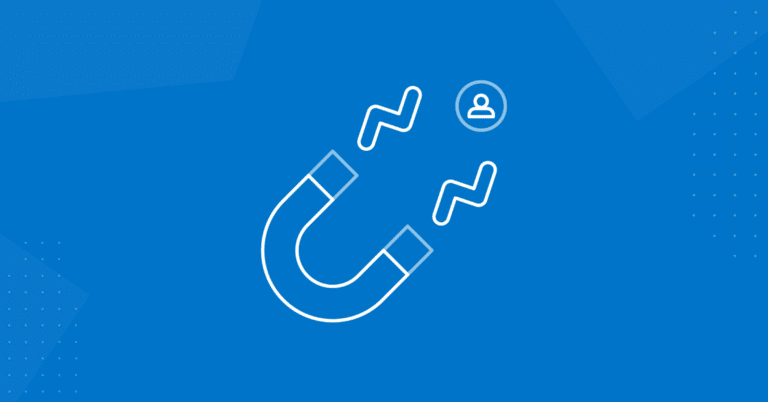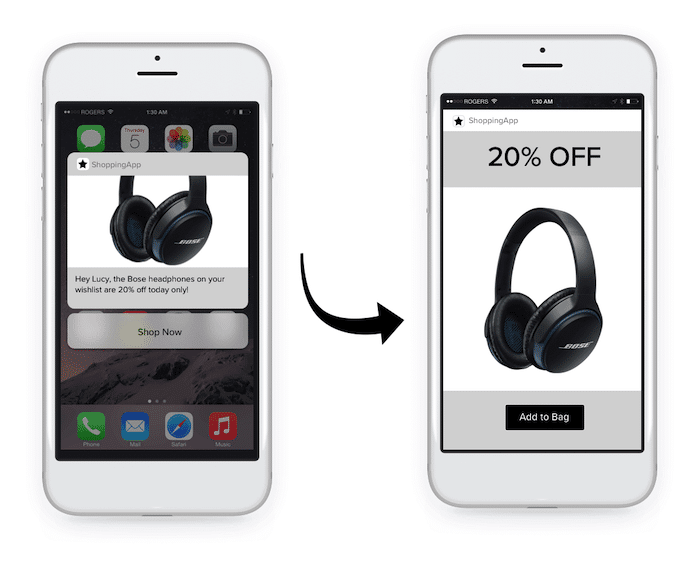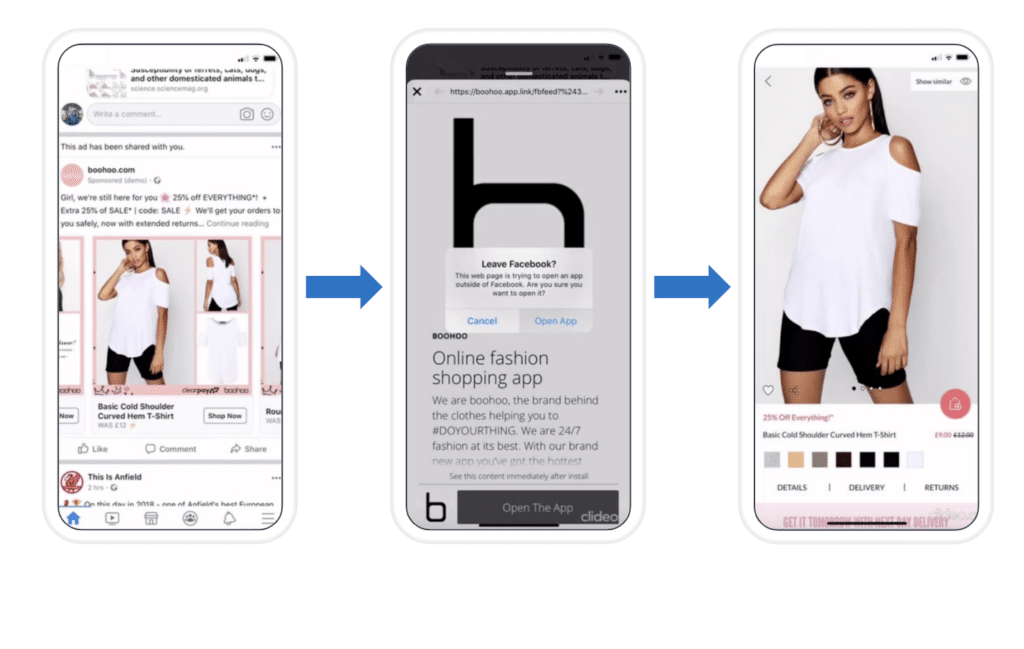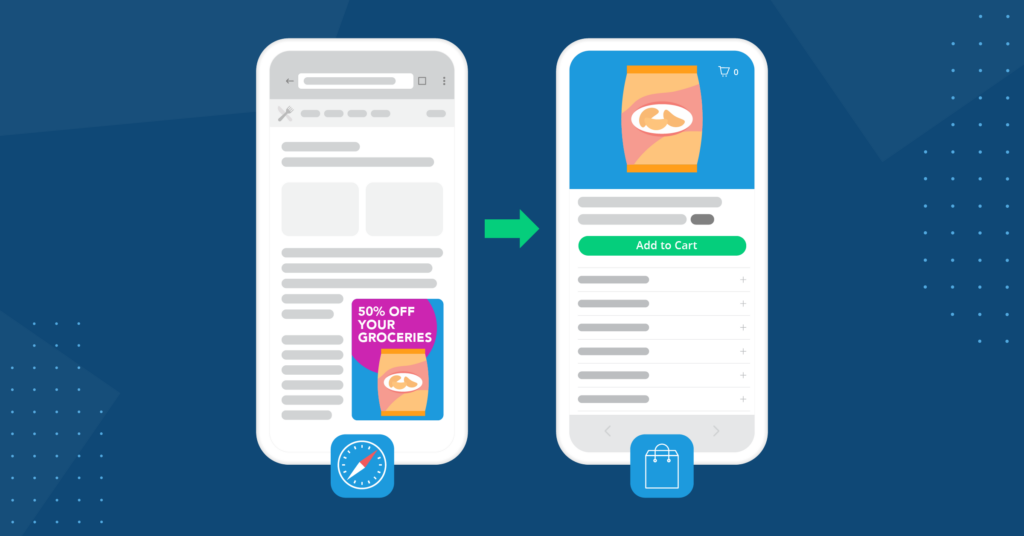What is mobile app re-engagement?
Traditionally, mobile marketers have focused on user acquisition to reach their app growth goals. However, as companies slashed acquisition budgets due to the COVID-19 pandemic, marketers have been forced to look to retention as an increasingly important growth metric. One way marketers are using app retention as a mobile growth strategy is through re-engagement.
In the world of mobile apps, re-engagement refers to driving existing users who already have your app installed back to interacting with your app. The goal is essentially to remind current users of your app, in order for them to perform in-app activity that ties to your business goals. Re-engagement is fundamentally different (and is a lot more effective, which we’ll explore more below) from acquisition, which aims to acquire new users who have never installed your app before.
Why is mobile app re-engagement important?
According to Amplitude, churned users are the largest percentage of most products’ potential user pools and are some of your most valuable users. These users are typically high value, especially if they’re using a competitor product.
Simply put, re-engaging and resurrecting lapsed mobile app users helps your bottom line. Re-engaging existing users is 5x cheaper than attempting to acquire new ones, helping reduce your CAC costs, which helps boost ROI. Because re-engaging lapsed users helps improve your user retention rates, this ultimately helps increase user lifetime value (LTV). And because higher user LTV correlates to the amount of money users spend in your app over the course of their lifetime, increasing LTV helps increase your company’s total revenue. Ultimately, re-engagement campaigns are an important part of any marketing strategy in order to optimize ad spend and to help increase ROI.
What does mobile app re-engagement look like?
Mobile app re-engagement campaigns entail targeting users who have not engaged with your app in a certain amount of time or who have not completed a post-install activity in order to get them using your app again. For example, if a user segment has downloaded your app but has not interacted with it for 30 days or another determined amount of time, you could run a campaign targeting those users to remind them of your app. Similarly, if a user performed an in-app activity such as adding a product to a cart or but never completed the purchase, you could also run a re-engagement campaign to prompt them to finish their order.
How is it different from web re-engagement?
Mobile app re-engagement differs from web re-engagement in that a mobile app re-engagement strategy specifically brings users into the app to complete an in-app action. This is accomplished with deep linking to provide a seamless user experience and ensure users are taken to the relevant in-app content related to the re-engagement campaign. Meanwhile, a web re-engagement campaign won’t necessarily bring users to the app, and will likely focus on bringing users to the desktop or mobile website. Web re-engagement campaigns additionally use web cookies to understand which users to target for a campaign, run personalized ads, and measure campaign performance, while mobile app re-engagement campaigns have traditionally used universal identifiers like the IDFA and GAID (although this is rapidly changing — we’ll discuss more about this change further below).
Ultimately, mobile app re-engagement will help you revive churned users and nudge existing users who have not interacted with the app to resume in-app activity, helping reach your key KPIs. Whether your goals are to get users to spend X amount of time in the app, click on a specific piece of content, or increase their in-app spending, your metrics for measuring re-engagement will depend on the type of app your business has, whether you’re an eCommerce brand, an app-first brand, or a social media app.
Types of Mobile App Re-engagement Campaigns
There are some typical and popular methods brands use to re-engage users, including:
Push Notifications
Push notifications can be an effective way to grab a user’s attention, but brands need to make sure they don’t overwhelm and annoy users. Effective push notifications deep link users into the app or specific in-app content, are timely and relevant, and are personalized to users’ interests and past behavior.
An example of a push notification from a shopping app. The push is personalized to make it relevant for the user, and directly brings the user to the product within the app.
However, you must convince your users to opt in to push notifications, a challenging feat in and of itself. And even if they do opt in, users can still easily ignore your push notifications with one click on their phone’s notification center. Getting your messaging right in your user permission modal and in the push notification itself — while complying with character limits — can be a complex strategy as well.
Email Campaigns
Email campaigns are a classic way to re-engage users due to its high readership and revenue potential when done right — for every $1 USD you spend on email marketing, you can expect an average return of $4. From sending users information about promotions, entertaining or educational content relevant to their interests, or notifying users about new products or features, email presents a multitude of opportunities to cater to the interests of various user groups to draw them back into your app.
That being said, email re-engagement can be notoriously tricky. Deep linking your emails on your own is near impossible, and capturing users’ attention — and their clicks — instead of losing them to the spam or unsubscribe button is an additional challenge.
Online retailer THE ICONIC deep links users from email to app for a better experience. This experience is essentially impossible to build in-house.
Ads
Finally, paid advertising is another popular way to run a re-engagement campaign. While organic/owned channels are the main ways for brands to interact with their existing user base and keep them engaged, paid re-engagement can be a great complement to this strategy — but it needs to be intelligently used. Compared to acquisition ads which usually cast a wide net to acquire any user who has the potential to be remotely interested, paid re-engagement ads tend to be more focused and have a narrow focus – for example, running ads for your app over the web or inside other apps your users are likely interested in.
With the help of sophisticated ad networks that allow you to launch campaigns at scale and target defined user groups, running a paid re-engagement campaign helps expand your reach throughout every stage of the funnel and allows you to reach a tailored, unique audience at the right time and place. For instance, using Google Display Network to target users who previously demonstrated intent to purchase, luxury watch retailer Watchfinder achieved 1,300% ROI on ad spend and reduced CPA by 34%, showing how paid re-engagement ads can reliably be used to optimize for success.
Examples of Paid App Re-Engagement Strategies
Paid app re-engagement ads are used most often to nudge users back to the app, especially when they show signs of reduced frequency of engagement. Rather than be reactive and wait until a user turns into a completely lapsed user, app marketers should better identify dormant users before they turn into lapsed users, and work to proactively bring back those user cohorts back into the app. This ensures lower churn and dropoff.
For example, an e-commerce app may look to re-engage a user if they haven’t PURCHASED for the last 3 months, a grocery delivery might want to bring back cohorts of users who haven’t OPENED the app in the last 30 days, a gaming app may look to re-engage users who haven’t INITIATED GAMEPLAY in the last 14 days, a subscription based Video Streaming app may want to re-engage a user in the last 30 days when the user’s yearly SUBSCRIPTION is up for renewal etc.
The definition of dormant and lapsed users, trigger event etc. vary from one app vertical to another, but the broad idea remains the same — to proactively engage with specific cohorts of customers via paid channels and keep them active on your app/brand to minimize churn.
Below are some examples of paid re-engagement ad strategies:
An app re-engagement ad for fashion retailer Boohoo on Facebook. After the user clicks the ad, they are led back into the Boohoo app for an easy shopping and checkout experience, eliminating user dropoff and churn. Because apps drive 3x more sales than the mobile web, routing your users to where they’re more likely to convert is especially important.
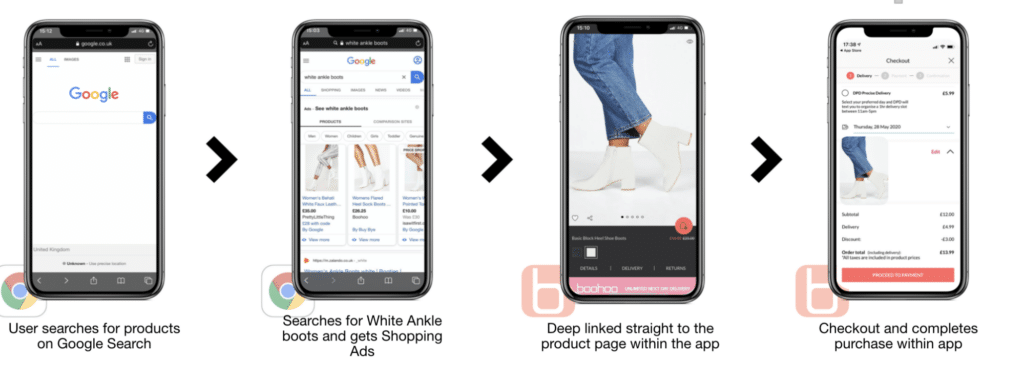
Boohoo also re-engages users with Google shopping ads. The ads deep link users straight into the Boohoo app for a seamless experience.
Re-engagement Windows Use Case: Leading Grocery App
This example shows how apps can use different windows and app activity signals to optimize their campaigns.
A leading grocery company defines an active user as someone who has transacted within 30 days, a dormant user as someone who hasn’t transacted between 30 and 60 days, and a lapsed user as someone who has not transacted for 60 days or more. The brand uses paid re-engagement to drive repeat transactions. Paid re-engagement ads are targeted towards users who have not opened the app in the last 30 days (which indicates the user is at risk of lapsing). Re-engagement inactivity windows are set to 30 days, which keeps the marketing budgets from being spent on any other user segments. The paid re-engagement ad is only given payout to the ad network if it drives a dormant/lapsed user back into the app and then drives a repeat transaction within the click-to-event window.
A fictional example of this grocery app’s paid ad re-engagement campaign.
The takeaway: Paid re-engagement channels that can use these app activity/inactivity signals to better target cohorts of users become a really powerful weapon in the paid marketer’s arsenal, and better optimize advertising spend and app growth.
Examples of this grocery app’s re-engagement campaigns include offering existing users a discount on their grocery order, as well as a buy one get one free promo. By using coupon codes and discount offers, the brand entices existing users to come back into the app and purchase — a common tactic for paid re-engagement ads.
Overall, the use cases for re-engagement, the tactics employed, measurement and performance monitoring all vary from industry to industry and app to app. Marketers who can identify the broader strategy and employ reengagement strategies effectively are able to boost overall business and app growth by driving loyalty, recurring revenue/repeat purchase and reducing dependence on new user acquisition channels for growth.
App inactivity windows and incrementality
There will always be certain cohorts of active users who will return to your app and engage frequently. When you target your paid reengagement budgets towards these active user cohorts who would have anyway visited your app organically, you run the risk of paid ads simply cannibalizing organic user intent and burning through your marketing budget. To account for this, MMPs usually have the “Reengagement Inactivity Windows”. This window defines the period between two events that a user must be inactive in order to define the later event as a re-engagement. By setting this to the desired window that makes sense for each business (7 day, 14 day, 30 day, 60 day etc.), app marketers can run campaigns that only get credit for re-engaging inactive users and bringing them back into the app – thus ensuring high-incremental business impact of paid reengagement campaigns.
Challenges with ads-based re-engagement
Normally, a marketer would run an ads-based mobile app re-engagement campaign by showing ads to existing users in order to get them back into the app. On iOS and Android, this is made possible by universal, device-level identifiers such as the IDFA and GAID. Because these IDs are the same for every app on the device, they provide a shared “name tag” that both advertisers and ad publishers can use to figure out which users to show ads to — and which users not to show ads to — to ensure ad spend is not wasted on users who are already highly engaged. Similarly, on the web, identifiers such as third-party cookies allow advertisers to find the right web users to show ads to.
The loss of universal IDs
However, the mobile industry is moving towards a world where universal identifiers will be unavailable, making re-engagement more difficult and less effective over both the web and across mobile apps. On the web, Google is planning to phase out their support of third-party cookies, making targeted advertising across the web more difficult.
For mobile app re-engagement, Apple’s changes to device-level ad attribution data on iOS 14.5 mean that marketers will not have access to IDFAs unless users explicitly consent to sharing them. If users do not opt in to sharing their IDFA, it will be impossible for your ad networks to find the right users to show re-engagement ads to, decreasing the effectiveness of your campaigns and increasing the potential for wasted ad spend, ultimately making it more difficult to reach your business goals.
We fully expect Google to do the same with the GAID on Android in the future, which would assign re-engagement campaigns on Android the same fate as those on iOS. The new reality is that the ability to use device-level data to run and measure mobile re-engagement campaigns is no longer a given — rather, it’s going to be a challenging feat. Re-engagement campaigns across both the web and mobile apps will be nowhere near the level of granularity and effectiveness marketers previously enjoyed.
So What Are You Supposed to Do?
Because running ads-based re-engagement campaigns is about to be a lot more difficult, you wonder if you should run re-engagement campaigns at all. However, because re-engagement is so valuable, we urge you not to give up on your efforts. Email campaigns and push notifications will still be possible because they are not reliant on device-level data, meaning that developing a robust owned strategy will become even more important. Ensuring that links in your cross-platform campaigns, including your mobile and desktop website, take users to the best experience, whether they have the app installed or not, is even more critical in ensuring users are brought back to engage with your app. That way, even if your re-engagement ads get shown to someone who does not have your app installed, they’ll still receive a good web fallback experience rather than a broken link that causes them to drop off and costs your business valuable dollars.
On the whole, we believe this change will push the industry from focusing on paid app installs to focusing on the holistic customer journey and connected user experience, which we consider a win. And although re-engagement is going to be more difficult, this simply means that marketers will need to find new ways to connect users with their app. For example, certain networks that are less reliant on universal IDs could support effective re-engagement campaigns without the need for IDs – for example, networks whose inventory is direct-to-device (e.g. preloads and other types of OEM inventory). We have no doubt that sharp marketers will be able to discover and create alternative methods to re-engage app users to drive business growth.






















